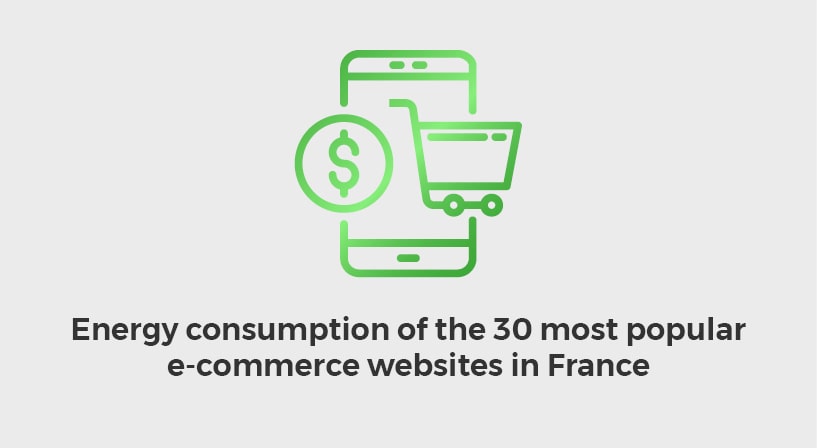We measured the energy and resources consumption of the most popular e-commerce websites in France. Thanks to a recent study of SimilarWeb and ECN introducing a ranking of the Top 100 e-commerce websites, we selected the top 30 websites in this ranking and compared them according to their consumption of energy and mobile resources based on a simple functional path representative of their market activity.
Why measure energy consumption?
A website that consumes less energy will be more efficient because it will be “frugal”, with latency times shorter especially on a mobile phone that can sometimes be already crowded, older or low-tech. We can talk about a better “inclusion” business if the service responds in an acceptable way for users who do not always benefit from a favorable network conditions (degraded or saturated network) in their navigation.
The battery life will also be a curb for the user who does not wish to activate services too greedy for its autonomy, especially if it intends to use them very regularly. But surfing the web via mobile is it consumer on a smartphone? In our 2019 study of the Top 30 most popular mobile apps in the world, we had measured web browsing which is on average the most consuming category compared to video applications, video games or social networks. Tt’s enough to make buyers doubt and value their battery life.
In addition, a less energy-consuming website, and this is not the least argument, ultimately improves the website SEO …
Indeed, the statistics of several tens of millions of visits in the month make it possible to imagine the extent of the impact throughout the chain of dissemination of the content and services of these websites. Even a slight improvement will benefit from a very important multiplier of reduction on the totality of the impact, whether on the user side or the server and network infrastructure. The digital actors must absolutely take into account this dimension of environmental responsibility in their business digital because as recalls the Shift Project, the digital climate impact will be equivalent in 2025 to that of light vehicles.
The 5 websites with the lowest energy consumption and the 5 most consuming ones

On the podium of the most energy-efficient websites, we find in first place the Rue Du Commerce website (10.6 mAh), LDLC (11.3 mAh) and ShowroomPrivé (12 mAh). Not far behind are the websites : Auchan (12.1 mAh) and Apple (12.4 mAh). The Rue Du Commerce website consumes 6.2% less than the second most energy-efficient one: LDLC and nearly 27% less than the average ranking (14.5 mAh).
On the side of the most energy-consuming websites, we find in last place the La Redoute website (18.1 mAh) followed by [Leroy Merlin] (https: //www.leroymerlin.fr/) (17.6 mAh) and Airbnb (16.8 mAh). Finally, the websites Boulanger and Zalando (16.4 mAh) share the 26th and 27th place. The most energy-hungry website La Redoute consumes 24% more than the average of the ranking.
Projection
If we project the measured consumption on a Nexus 6 (voltage 3, 7 Volt), therefore only on the smartphone of the user, according to the average time of visit on a month: the flop 3 of the navigations the more consumers over the month are the sites: Leboncoin (99.34 MWh / month), Amazon (56.36 MWh / month), Ebay (19.34 MWh / month) . These 3 sites are at the same time penalized by a large number of visits, a rather long average visit time and a strong consumption of the purchase route.
The top 3 is made up of RueDuCommerce, LDLC and Auchan which are much less frequented but which also have the advantage of being in the best students on the market. consumption of the purchase route. If a site like Leboncoin was at the consumption level of the RueDuCommerce website, they could save their smartphone users more than 30 GWh/month, the equivalent of a country’s electricity consumption. like Haiti.
The projection of this Top 30 e-commerce websites, if all users had a Nexus 6 smartphone according to statistics visits indicated, would be about 3.7 TWh per year, the equivalent of the annual consumption of a country like Somalia. The server and network impacts were not taken into account in this study. It would be interesting to be able to estimate server side with the editors.
Energy consumption of 30 e-commerce websites

Only 12 websites are below the average (14.5 mAh) of this ranking. There is a 1.7 ratio between the least energy-consuming site (Rue Du Commerce) and the most energy-intensive (La Redoute).
Methodology
The measurements were carried out by our laboratory on the basis of a standardized protocol: Nexus 6 Smartphone, Android 6, Wi-Fi, low brightness. 3 campaigns were conducted and the value used is the average of these 3 measurements. The measurement campaigns respect a specific user scenario adapted to each website (launch of Google Chrome, access to the URL of the website, search scenario, selection, basket and display basket)
Summary table of the 5 best sites and the 5 worst ones
| Website | Energy consumption (mAh) | Exchanged data (Mo) | Memory consumption (Mo) |
|---|---|---|---|
| RueDuCommerce | 10.6 | 2 | 337.5 |
| LDLC | 11.3 | 6.3 | 356.4 |
| ShowroomPrivé | 12 | 3.7 | 335.6 |
| Auchan | 12.1 | 4.8 | 347 |
| Apple | 12.4 | 6.6 | 353.6 |
| … | … | … | … |
| Zalando | 16.4 | 6 | 332.2 |
| Boulanger | 16.4 | 6 | 332 |
| AirBnb | 16.8 | 6.9 | 371.5 |
| LeroyMerlin | 17.6 | 4 | 346.4 |
| La Redoute | 18.1 | 5 | 390.9 |
Do you want to access the results of a particular site? Contact us!
Find our latest study: GPS Apps
Comparative study ideas? Contact us!

